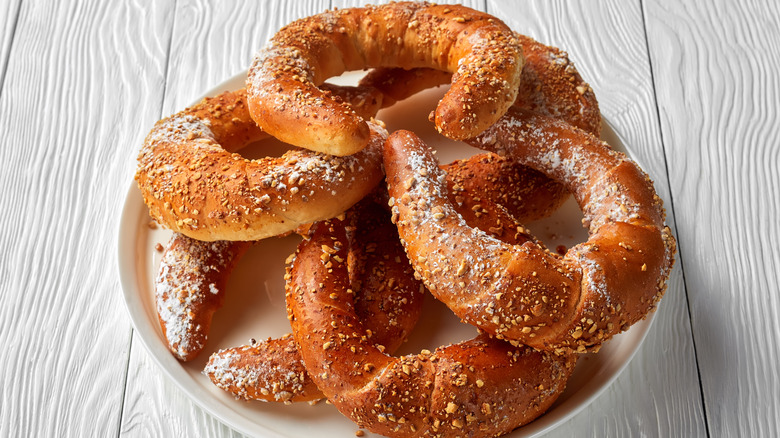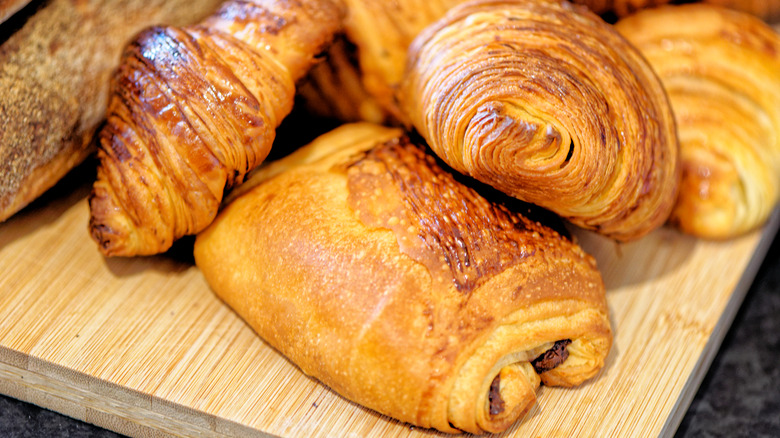Croissants Got Their Start In Austria—Not France
As far as French baking goes, croissants feel fairly iconic. In fact, there's a meme floating around TikTok these days that samples the soundbite of two people humorously overexaggerating the French pronunciation of "croissant" as "qua-so." That's all there really is to the joke — the idea that these pastries are obviously so overly French ... but are they?
Such buttery, crescent-shaped, yeast-based pastries (perfect for stuffing full of sweet or savory foods) are less ingrained in French cuisine, historically, than imagined. They only became popular there in the 1900s, after all, and it wasn't until the late 20th century that the fast food industry took this golden culinary item global. During the century prior, croissants were merely viewed as expensive, foreign specialties in France. Indeed, croissants in all their crispy yet tender glory came to the French from the east, more specifically, from the fellow European nation of Austria.
Kipfel is a storied curved bread
The Austrian precursor to the French croissant is the kipfel (also called "kifli" in some recipes). Naturally similar to the modern croissant, kipfel consists of butter or lard plus toppings like almonds, cheese, ham, jam, or sugar. Yet, moon-shaped bread as a European tradition seems to be roughly 1,000 years old, and for hundreds of years, Austria has pulled from myriad different cultures to form its own varied cuisine. Thus, the exact origin of kipfel is ambiguous.
However, the earliest known record of this specific lunar-inspired bake comes from a 1227 poem that mentions kipfel as a Christmas dessert gifted to a duke by Viennese bakers. Despite this fact, there is a popular legend that, in 1683, an early-to-rise Austrian baker heard invading Turks tunneling beneath their city during the siege of Vienna. This baker sounded the alarm, which allowed the Austrians to emerge victorious, and kipfel was invented to celebrate the baker's watchfulness. Its curved shape in particular was supposedly chosen to mimic the crescent moon on the Ottoman flag. This is obviously questionable given the existence of the 13th-century poem, but the real question is: How did France even get involved at all?
Viennoiserie is both French and Austrian
There are similarly conflicting stories about how kipfel became the croissant. Some say that Queen Marie Antoinette, originally from Vienna, was responsible for bringing this treat to France, but that claim lacks supporting evidence. More likely, it was August Zang, who opened Paris' first Viennese bakery during the 1830s then popularized this Austrian food. Soon enough, other bakers began to follow his lead and sold their own kipfel. Then, once puff pastry was applied to the recipe, kipfel essentially became the croissant. (Even so, kipfel persists as a popular breakfast item in Austria).
This transition makes the croissant emblematic of Viennoiserie, the category of Vienna-style breakfast pastries made in France. It's a sort of halfway point between French bread and patisserie (French pastry), using enriched puff pastry, white flour, and/or yeast cultures to create flaky, quick-rising bakes. Croissants do not stand alone in this category, though. Brioche, chausson aux pommes, oranais, pain au chocolat, and pain aux raisins also qualify. In this way, despite not technically originating in France, the croissant is still a true French icon and a leader in its field.


